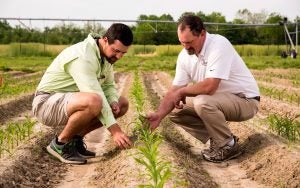The only things you can count on in life are death and taxes, as the old adage warns. Unless you’re a farmer. Then you can look forward to death, taxes, and pests. Whether those pests are weeds, insects, worms, or fungi, they can wreak havoc on crops. So crop-protection tools, including pesticides, are pretty darn important. They literally make the difference between food for the table and a failed harvest.
The way these important tools are regulated is a big deal, too. But the U.S. Environmental Protection Agency’s new “biological evaluation” makes market access for these trusted pesticides harder — and threatens to remove them entirely. The evaluation is the EPA’s new method of evaluating the possible effects of pesticides on federally listed endangered and threatened species, as well as proposed additions and critical habitat.
The evaluation itself isn’t the problem. Farmers are just as concerned about endangered species as everyone else. That’s precisely why the Federal Insecticide, Fungicide, and Rodenticide Act (FIFRA) requires the EPA’s initial assessment, and mandated review every 15 years, to include a scientific assessment of how pesticides affect endangered species.
In reality, the EPA is constantly making these assessments. It does a comprehensive survey of scientific literature for the latest understanding of whether a chemical impacts human health and the environment. By the time the EPA has completed the various assessments, it’s time to start all over again. It’s an incredibly thorough process. And it has served us well for decades.
The problem is how the EPA conducts these new biological evaluations, and the resulting conclusions.
Take the two most recently released evaluations of irreplaceable herbicides — glyphosate and atrazine. Both atrazine and glyphosate have long established safety records. Atrazine, which is used annually on approximately 60 percent of U.S. corn acres, was first registered in 1958. The EPA has conducted regular FIFRA reviews over the decades. And 13 different EPA scientific advisory panels have all found it’s safe for use as instructed on the product’s label.
Registered in 1974, glyphosate’s record isn’t as long. But the EPA has similarly scrutinized it and concluded it poses no risks to human health. It’s also extremely benign in the environment.
Yet the EPA’s biological evaluation reached a baffling conclusion. It found atrazine is “likely to affect” nearly every endangered species in the continental U.S. And glyphosate was even worse. It was deemed “likely to adversely affect” 93 percent of listed species.
These shocking results stem from EPA’s attempt to meet a court-ordered deadline. Radical environmental groups sued the EPA to conduct these biological evaluations. Under the gun, the agency utilized extremely conservative and flawed methods to finish as quickly as possible.
Some of the most egregious of these were deeming entire species as adversely affected by atrazine if one, individual member was affected. So if one [Virgin River Chub or Squirrel Chimney Cave shrimp or West Indian Manatee] — for which EPA said it had the “weakest evidence” — negatively encountered an herbicide, the entire species was thrown in. Further sloppiness is revealed by the fact that several already-extinct species were counted as “adversely affected” by atrazine.
Quite simply, this flawed process inaccurately depicts atrazine as a danger for endangered species.

It’s irritating because the EPA failed to fulfill its promises to growers to fix the biological evaluation’s flawed process, like making sure that high-quality studies carry more weight than low-quality studies. The EPA needs to reform these evaluations immediately; this decision will have a huge impact on the regular use of atrazine, as well as future re-evaluations.
It’s hard to miss how important these and other effective herbicides actually are. Depending on the crop, weeds can radically reduce a crop’s yields and quality, causing an estimated 26 percent to 80 percent of pest losses. A recent study by researchers at Kansas State University found that uncontrolled weeds would cut corn and soybean yields by half in the U.S. and Canada, and cost $43 billion in economic damages.
And we know strategic herbicide use also promotes soil health. Farmers don’t have to disturb the soil with tillage or plowing, leaving the soil intact. No-till farming greatly reduces soil erosion and runoff, and increases soil sequestration. Simply stated, herbicides allow farmers to grow more food with less water on less land, leaving natural habitats untouched and uncultivated.
Here’s the bottom line: If farmers lose the ability to use atrazine, glyphosate, and other herbicides, the costs to farms will increase. The price of food will go up. Yields will plummet. And farm families will go bankrupt. With so many uncertainties already facing the ag sector, we can’t weather this as well.
Comments on EPA’s atrazine evaluation are due this Friday. We need everyone who cares about modern agriculture to speak up. Here’s how to do it:
Click here. Enter docket no. EPA-HQ-OPP-2020-0514 in the search bar and click the search button. Click the comment button below “Draft Endangered Species Act Biological Evaluations: Atrazine, Simazine, and Propazine Registration Review.
Amanda Zaluckyj blogs under the name The Farmer’s Daughter USA. Her goal is to promote farmers and tackle the misinformation swirling around the U.S. food industry.


